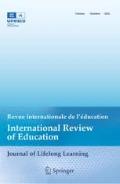Abstract
When ZANU (PF) came to power in 1980, it had promised to establish free and compulsory primary and secondary education for all children in Zimbabwe. The Ministry of Education has achieved remarkable increases in school enrolments, particularly at secondary level. It has also undertaken to allow all pupils to sit the ‘O’ Level examinations after four years of secondary schooling. But by so doing it has encouraged a belief in the importance of academic qualifications and a crisis of expectation among pupils. There are insufficient places for those who wish to continue to Sixth Form (higher secondary) studies, a lack of alternative vocational training, and an inadequate rate of creation of new jobs for school leavers. There seem but three ways out: to cut defence spending in favour of education, to send students abroad for higher training, or to develop new employment and training schemes, perhaps after an imported model.
Zusammenfassung
Als die Afrikanische Nationalunion von Simbabwe, ZANU (PF), 1980 an die Macht kam, hatte sie zugesichert, eine allgemeine unentgeltliche Schulpflicht für die Primar- und Sekundarstufen in Simabwe einzuführen. Das Erziehungsministerium hat einen erstaunlichen Zuwachs an Einschulungen, besonders auf der Sekundarschulebene erzielt. Darüberhinaus hat das Ministerium Schritte eingeleitet, so daß Schüler die Mittlere Reife (‘O’ Level) nach vier Sekundarschuljahren ablegen können. Durch diesen Schritt wurde gleichzeitig die überzeugung von der Bedeutsamkeit akademischer Qualifikationen gestärkt und eine Erwartungskrise unter den Schülern ausgelöst. Plätze für Schüler, die die höhere Sekundarstufe (Sixth Form) weiterbesuchen möchten, reichen nicht aus, es mangelt an alternativen Berufsausbildungsmöglichkeiten und an neugeschaffenen Arbeitsplätzen für Schulabgänger. Nur drei Auswege scheinen möglich zu sein: die Verteidigungskosten zugunsten des Bildungswesens zu kürzen, Schüler zur höheren Ausbildung ins Ausland zu schicken, oder aber neue Berufs- und Ausbildungsprogramme gegebenfalls nach einem importierten Modell zu entwickeln.
Résumé
Lorsque le Front Patriotique (ZANU - PF) parvint au pouvoir en 1980, il avait promis d'établir un enseignement primaire et secondaire gratuit et obligatoire pour tous les enfants du Zimbabwe. Le Ministère de l'Education a réussi à faire progresser de manière remarquable le taux de scolarisation, en particulier dans le second degré. Il a également décidé de permettre à tous les élèves de passer les examens du niveau ‘O’ après quatre années d'enseignement secondaire. Mais en agissant ainsi, il a encouragé une croyance en l'importance des titres scolaires et une crise d'attente chez les élèves. Les places sont insuffisantes pour ceux désirant poursuivre leurs études jusqu'à la 6e classe (enseignement secondaire supérieur), un système alternatif de formation professionnelle fait défaut et le taux de création de nouveaux emplois pour les jeunes quittant l'école est inadéquat. Trois issues semblent se dessiner: augmenter le budget de l'éducation en réduisant celui de la défense, envoyer les élèves à l'étranger pour y recevoir une formation supérieure, ou bien développer de nouvelles structures d'emploi et de formation, à l'instar d'un modèle étranger notamment.
Similar content being viewed by others
Rights and permissions
About this article
Cite this article
Mackenzie, C.G. Zimbabwe's educational miracle and the problems it has created. Int Rev Educ 34, 337–353 (1988). https://doi.org/10.1007/BF00598220
Issue Date:
DOI: https://doi.org/10.1007/BF00598220



